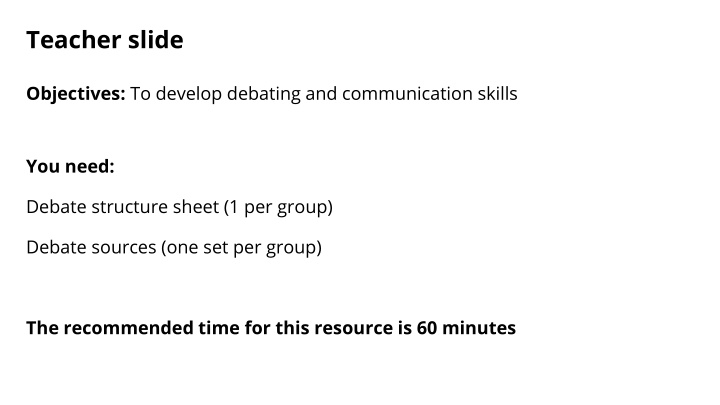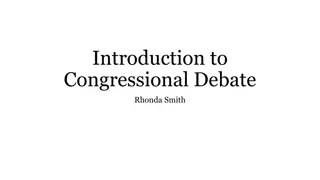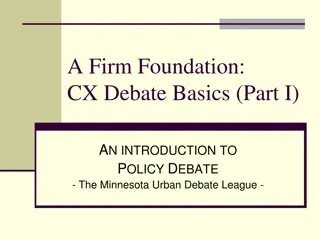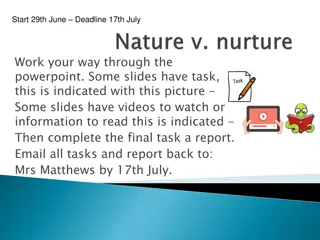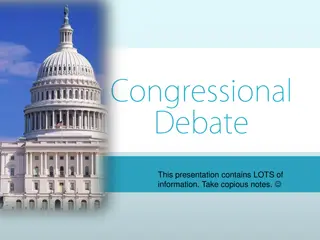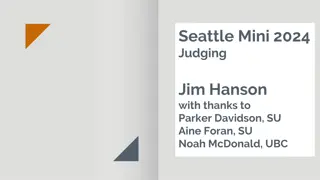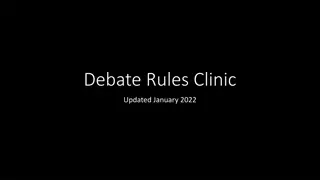University Debate Activities
Engage in structured debate activities to develop debating and communication skills. Explore different statements regarding university choices and participate in a formal debate with assigned roles. Analyze sources, present arguments, and engage in constructive discussions. Enhance critical thinking and public speaking abilities in a supportive learning environment.
Uploaded on Mar 02, 2025 | 1 Views
Download Presentation

Please find below an Image/Link to download the presentation.
The content on the website is provided AS IS for your information and personal use only. It may not be sold, licensed, or shared on other websites without obtaining consent from the author.If you encounter any issues during the download, it is possible that the publisher has removed the file from their server.
You are allowed to download the files provided on this website for personal or commercial use, subject to the condition that they are used lawfully. All files are the property of their respective owners.
The content on the website is provided AS IS for your information and personal use only. It may not be sold, licensed, or shared on other websites without obtaining consent from the author.
E N D
Presentation Transcript
Teacher slide Objectives: To develop debating and communication skills You need: Debate structure sheet (1 per group) Debate sources (one set per group) The recommended time for this resource is 60 minutes
University: The Big Debate
Warm Up Have a look at the following statements. If you agree with the statement, move to the right of the room. If you disagree, move to the left. Agree Disagree
Statement #1 When you re 18, if you have no idea about what career you might like to pursue, you should go to university. Agree Disagree
Statement #2 University can t teach you the same amount that apprenticeships can. Agree Disagree
Statement #3 It s important that you go to a Russell Group university. Agree Disagree
The Motion: Everybody should go to university 1 x group for the motion (supporting it) 1 x group against the motion (do not support it) Per group, at least: 1 x Scribe 1 x Opening Speaker 1 x Rebuttal Speaker Take any initial poll How many of you support the motion? How many of you do not support the motion? How many of you are not sure?
Part 1: Research As a group, read through the sources you have been provided with and pick out the three strongest reasons for your argument. The scribe(s) should take responsibility for noting these down clearly for everyone in the group to refer to. Time: 10 mins
Debate Structure Read your debate structure sheet to format your debate. Then follow the instructions on the next slide to present your debate.
Part 2: Present your arguments The Opening Speaker(s) should present your group s three strongest reasons to the other group. This should take no longer than 3 minutes. The scribe(s) from the opposing group should note down the three reasons given whilst the speakers are talking. Time: 3 minutes for each group
Part 3: Rebuttal planning As a group, you should plan your reply to the opposing group s three strongest reasons. The scribe(s) should take responsibility for clearly writing down the planned rebuttal, and this should then be delivered by the Rebuttal Speaker(s) in no longer than 3 minutes. Time: 5 mins for planning, 3 minutes for delivery per group
Part 4: Questions Anyone from each group may now ask the other group questions about their arguments or rebuttal. To ask a question, raise your hand. If you want to respond to a question, raise your hand. If more than 1 person wants to respond to a question, you are allowed 30 seconds to decide which of you will respond. Only 1 person can respond to 1 question. Time: Up to 10 mins
The Motion: Everyone should go to university Regardless of which group you were in, what is your opinion on the motion now? Agree Disagree
